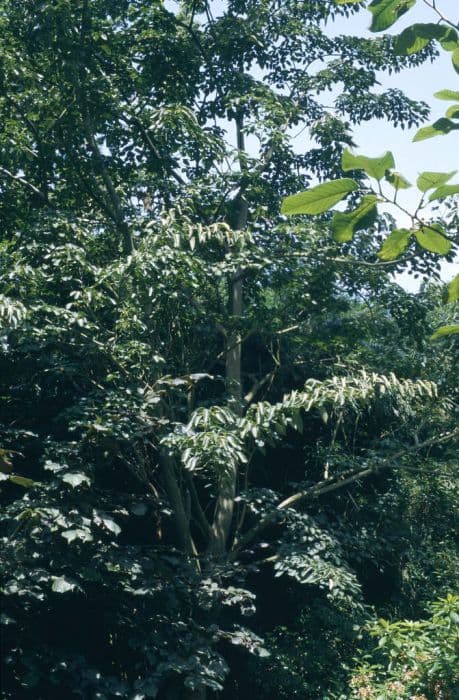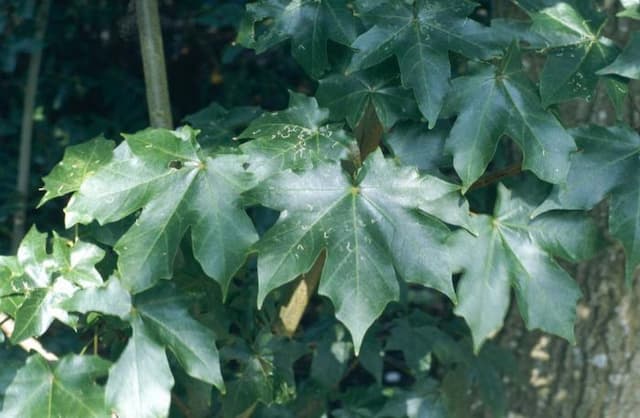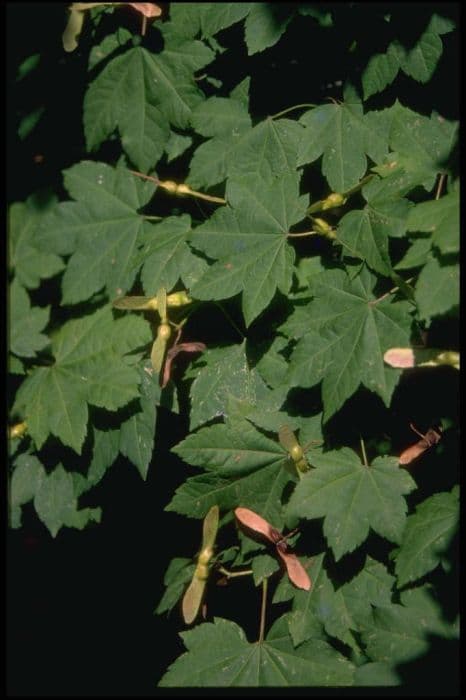Three-flowered Maple Acer triflorum

ABOUT
The Acer triflorum, commonly known as the three-flower maple, is a species known for its aesthetic appeal in a garden setting, with features that deliver visual interest across seasons. The most striking characteristic of the three-flower maple is its exfoliating bark, which peels away in strips to reveal a mosaic of colors beneath, including shades of cinnamon, green, and pale yellow. This feature becomes more pronounced as the plant matures and adds a unique texture, often compared to the appearance of shaggy paper. The foliage of the three-flower maple is also notable for its beauty. In the spring, the leaves emerge in a soft green color, each leaf typically having three pointed leaflets, which is a distinguishing trait and the reason for its common name. The leaves are arranged in a trifoliate pattern, providing a lush and full appearance to the plant. As the seasons change and autumn arrives, the leaves undergo a dramatic transformation, turning into a spectacular display of colors ranging from bright yellow to rich red, making the three-flower maple a standout specimen for fall color. Adding to its ornamental qualities, the plant produces modest yet attractive flowers. The small, yellow-green flowers bloom in clusters of three – another nod to its name. They are understated but contribute to the plant's charm during their brief appearance in spring. After flowering, the plant bears fruit that manifests as paired samaras, which are winged nuts. These helicopter-like seeds are common among maples and add an additional element of interest as they mature and eventually disperse in the wind. Overall, the three-flower maple's combination of exfoliating bark, attractive foliage, understated flowers, and charming samaras makes it a beloved choice for those seeking a plant with year-round visual interest and understated elegance.
About this plant
 Names
NamesFamily
Sapindaceae.
Synonyms
Three-flowered Maple, Three-flower Maple.
Common names
Acer triflorum
 Toxicity
ToxicityTo humans
Acer triflorum, commonly known as three-flowered maple, is not considered toxic to humans. There are no well-documented cases of poisoning or toxic effects from ingesting parts of this plant.
To pets
Three-flowered maple (Acer triflorum) is generally not considered toxic to pets either. There is no significant evidence that suggests ingesting parts of this specific maple tree causes poisoning in pets. However, as with any non-food plant, ingestion in large quantities could potentially cause mild stomach upset.
 Characteristics
CharacteristicsLife cycle
Perennials
Foliage type
Deciduous
Color of leaves
Green
Flower color
Yellow
Height
20-30 feet (6-9 meters)
Spread
15-25 feet (4.5-7.5 meters)
Plant type
Tree
Hardiness zones
5
Native area
Korea, China, Japan
Benefits
 General Benefits
General Benefits- Ornamental Value: Acer triflorum, commonly known as Three-flowered maple, is appreciated for its ornate exfoliating bark and attractive foliage, which adds visual appeal to landscapes.
- Seasonal Interest: It offers stunning autumn coloration, as the leaves turn various shades of yellow, orange, and red, providing a seasonal spectacle.
- Shade Provision: As a deciduous tree, Three-flowered maple creates a decent canopy that offers shade during the warmer months.
- Habitat Support: The species provides habitat and a food source for various birds and wildlife, contributing to local biodiversity.
- Low Maintenance: Generally, Three-flowered maples are low maintenance, requiring minimal pruning and care once established.
- Adaptability: Acer triflorum can adapt to a range of soil types, though it prefers well-drained soils, making it versatile for different landscape conditions.
 Medical Properties
Medical PropertiesThis plant is not used for medical purposes.
 Air-purifying Qualities
Air-purifying QualitiesThis plant is not specifically known for air purifying qualities.
 Other Uses
Other Uses- Acer triflorum, commonly known as the Three-flowered Maple, can be used in small-group plantings for an aesthetic appeal during the various seasons with its distinctive trifoliate leaves and striking fall coloration.
- Its peeled bark, which reveals a smooth and interesting texture and color, is often used in landscape design for visual interest, especially during the winter months when other plants have lost their foliage.
- The wood of Acer triflorum is occasionally used in fine woodworking for decorative objects, as it can exhibit an attractive grain once polished.
- Despite being less common than other maples, the Three-flowered Maple's wood can be utilized in the crafting of musical instruments for its acoustic properties.
- Creative gardeners sometimes use the branches and leaves of Acer triflorum in floral arrangements, especially in autumn when the leaves turn a vibrant range of colors.
- The seeds of the Three-flowered Maple are sometimes used by hobbyists in seed art or jewelry making due to their unique winged shape.
- Because of its moderate size and non-invasive roots, Acer triflorum can be planted in urban or street settings, providing shade and enhancing the streetscape.
- Its distinct three-leaf structure can inspire patterns and designs in textile or graphic arts, utilizing it as a motif for artists and designers.
- In educational settings, Acer triflorum can be used to teach botany and horticulture, highlighting the unique characteristics of maple species.
- Photographers and nature enthusiasts often seek out the Three-flowered Maple as a subject for photo shoots, especially in autumn due to its photogenic qualities.
Interesting Facts
 Feng Shui
Feng ShuiThe Three-flowered Maple is not used in Feng Shui practice.
 Zodiac Sign Compitability
Zodiac Sign CompitabilityThe Three-flowered Maple is not used in astrology practice.
 Plant Symbolism
Plant Symbolism- Resilience: The Acer triflorum, commonly known as the Three-flowered Maple, can adapt to a variety of soil types and climates, symbolizing the ability to withstand tough conditions.
- Strength: As a maple species, the Three-flowered Maple represents strength and endurance, qualities inherent in its robust wood.
- Beauty in Simplicity: The understated elegance of its small, tri-petaled flowers emphasizes that beauty often lies in simple, modest forms.
- Growth and Expansion: The tree's branching pattern and expanding canopy symbolize personal growth and the expanding reach of one's endeavors.
- Elegance: The attractive foliage and the graceful shape of the tree convey a sense of elegance and refined beauty.
 Water
WaterThe Threeflower Maple should be watered deeply and thoroughly to ensure the soil is moist to a depth of a few inches. It is ideal to water the plant once a week, adjusting based on weather conditions, with more frequent watering during hot, dry periods and less during cool, wet times. During the growing season, providing approximately 1 to 2 gallons per week should be sufficient, depending on soil type and climate. It's important to avoid overwatering as consistently wet soil can lead to root rot. Ensure the plant has well-draining soil to prevent water from accumulating at the roots.
 Light
LightThe Threeflower Maple thrives best in full sun to partial shade. An ideal spot would provide it with morning sunlight and protection from the intense heat of the afternoon sun. It's adaptable, however, and can do well in a spot that receives light dappled shade throughout the day, helping to prevent leaf scorch in areas with particularly hot summers.
 Temperature
TemperatureThe Threeflower Maple is hardy and can withstand a range of temperatures. It can survive minimum temperatures as low as -20°F and is suitable for USDA hardiness zones 5 through 8. The ideal growing temperature for this maple is between 60°F to 75°F. It's important to protect the tree from extreme cold and hot temperatures which may cause damage to the tree.
 Pruning
PruningPrune the Threeflower Maple to shape it and remove any dead, damaged, or diseased limbs. Pruning is best done during late winter or early spring before new growth begins. It's typically not necessary to prune this tree often, only to maintain its health and desired shape. The best time for heavy pruning is when the tree is dormant to minimize stress and prevent sap loss.
 Cleaning
CleaningAs needed
 Soil
SoilThe Three-flowered Maple (Acer triflorum) thrives in well-drained, slightly acidic to neutral soil with a pH of 5.5 to 7.5. The best soil mix for this plant includes a combination of loam, organic compost, and a small amount of sand for improved drainage. Regular mulching can help to maintain soil moisture and provide additional organic matter.
 Repotting
RepottingThe Three-flowered Maple does not need frequent repotting and can often remain in the same pot for several years. It is best to repot this plant every 3-5 years or when it becomes root-bound. Spring is the optimal time for repotting to allow the plant to recover during the growing season.
 Humidity & Misting
Humidity & MistingThe Three-flowered Maple prefers moderate to high humidity levels but is adaptable to a wide range. Aiming for a humidity level between 40-60% is suitable for the health of the plant, but it can tolerate lower humidity conditions commonly found in most temperate climates.
 Suitable locations
Suitable locationsIndoor
Provide bright, indirect light and water when topsoil is dry.
Outdoor
Plant in partial shade, shelter from harsh winds, well-draining soil.
Hardiness zone
4-8 USDA
 Life cycle
Life cycleAcer triflorum, commonly known as the Three-flowered Maple, begins its life cycle as a seed, which requires stratification through winter temperatures to break dormancy. Upon spring's warmth and moisture, the seed germinates, producing a small seedling with characteristic maple leaves. The seedling grows into a juvenile, strengthening its root system and increasing in height and girth. As it matures, the tree develops a notable three-flowered inflorescence for which it is named, typically after several years. Reproductive maturity is marked by the production of winged samaras, which are dispersed by the wind for propagation. Finally, the tree enters a period of senescence after many decades, where growth slows, and it eventually dies, returning nutrients to the ecosystem.
 Propogation
PropogationPropogation time
Early spring
Propogation: The Three-flowered Maple (Acer triflorum) is most commonly propagated through seed. Seed propagation should ideally take place in the fall after the samaras (the winged fruits) have ripened. The seeds first require a period of cold stratification to break dormancy, which can be achieved by mixing the seeds with damp sand and storing them in a refrigerator for about 90 to 120 days at temperatures of 33-41°F (0.5-5°C). After stratification, the seeds are sown in a well-drained seed starting mix, covering them with a thin layer of soil. They should be kept moist and will typically germinate with the arrival of spring. Seedlings require careful attention to ensure they do not dry out and can be transplanted to individual pots once they have developed a strong root system.









